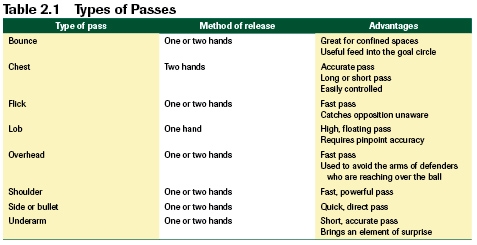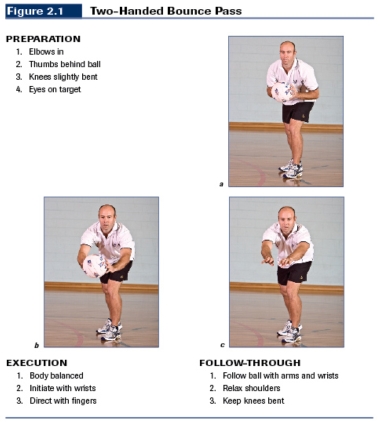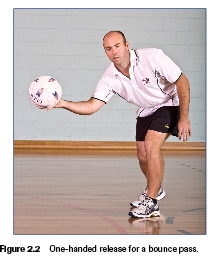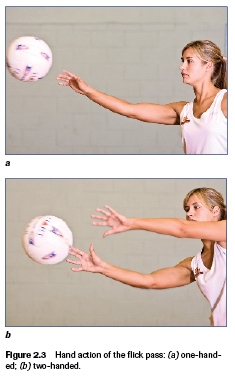Mastering netball passes key to keeping opponents guessing
This is an excerpt from Netball: Steps to Success - 2nd Edition by Wilma Shakespear & Margaret Caldow.
Types of Passes
Netball throws fall into two categories: two-handed and one-handed passes. Within these categories are high-ball and low-ball passes that can be delivered with speed or floated into the space that a team member has created. Make sure you are proficient with either hand as well as with both hands. The strong defensive pressure on every pass that can be seen at the top levels of the game has resulted in two-handed passes, particularly the overhead pass, being used more frequently by all teams.
Most of the passes that you are introduced to here can be executed with one or two hands. These include the bounce, flick, overhead, side or bullet pass, shoulder and underarm. The lob is the one-handed pass that we cover; and the chest pass, the two-handed.
The passes and their advantages are listed in table 2.1. Mastering these basic techniques will enable you to develop a versatile range of throws that will keep your opponents guessing.
If you are a very young player, you might find it easier to use a smaller ball and try two-handed passes first. You will find that using both hands gives you more control and power initially.
One- or Two-Handed Passes
Passes that can be executed with either one or two hands are the easiest throws to begin with. Your hands sit either behind the ball or on the side of the ball. Your wrists and fingers guide the ball, and your elbows, arms and body weight generate speed and distance on the pass.
For the beginner the two-handed version enables a good long throw, even though the player may not have yet developed much upper-body power.
The more experienced netballer should be able to work the one- or two-handed version of the pass. Really good players can pass with either hand and from both sides of the body. Having a broad range of passes that you can use will be an asset in match play.
Remember: The two-handed pass has a built-in safety device. It can be retrieved quite easily at any point before the final release. The one-handed pass, on the other hand, is often difficult to retrieve once the throwing action has begun.

One- or Two-Handed Bounce Pass
Hold the ball firmly in the fingertips of both hands (figure 2.1a). Flick your wrists and fingers to release the ball; you can use either one hand or two hands, as shown in figure 2.1b. (The one-handed release is shown in figure 2.2.) For the short bounce, aim to have the ball bounce close to the receiver's feet. For a long bounce pass, generate more speed and power to create a higher bounce. Follow through with the arms, fingers and wrists while relaxing your shoulders and deeply bending your knees to maintain body balance (figure 2.1c).


In a match play situation the placement of the pass will be determined by the defender's positioning. Make sure that when you practise you are able to deliver to a variation of positions-front, right and left sides, and both stationary and moving.
The bounce pass allows an element of surprise because you can disguise the two-handed release so well. It is frequently used in and around the goal circle as attackers endeavour to outwit defenders. However, it is also used to good effect anywhere on the court.
Remember, the ball can bounce only once before it gets to the receiver.
One- or Two-Handed Flick Pass
The flick pass is no doubt the quickest way to propel the ball forward. The ball is quickly controlled and then moved on from the catching position. A flick of the wrists sends the ball quickly to the receiver. Its great strength is the element of surprise because it does not allow the defender time to recover.
Hold your arms in the catching position. Quickly roll your wrists towards the receiver and use your fingers to flick the ball to the receiver (figure 2.3). Make sure that your wrists and fingers not only generate power to propel the ball onwards but also direct the flight. For a short flick, a light touch is required. A longer flick requires more power.

SHOP

Get the latest insights with regular newsletters, plus periodic product information and special insider offers.
JOIN NOW
Latest Posts
- Authenticity was key to McKinney’s NIL success
- AI—A new tool for sport PR pros
- Essential skills for sport PR practitioners
- Employ these tactics when pitching a story to the media
- How does ergonomic analysis and intervention enhance safety and reduce injury risk?
- Common movement patterns in competitive cycling


